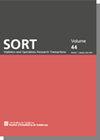Efficiency of propensity score adjustment and calibration on the estimation from non-probabilistic online surveys
IF 1.2
4区 数学
Q4 OPERATIONS RESEARCH & MANAGEMENT SCIENCE
Sort-Statistics and Operations Research Transactions
Pub Date : 2018-12-21
DOI:10.2436/20.8080.02.73
引用次数: 13
Abstract
One of the main sources of inaccuracy in modern survey techniques, such as online and smartphone surveys, is the absence of an adequate sampling frame that could provide a probabilistic sampling. This kind of data collection leads to the presence of high amounts of bias in final estimates of the survey, specially if the estimated variables (also known as target variables) have some influence on the decision of the respondent to participate in the survey. Various correction techniques, such as calibration and propensity score adjustment or PSA, can be applied to remove the bias. This study attempts to analyse the efficiency of correction techniques in multiple situations, applying a combination of propensity score adjustment and calibration on both types of variables (correlated and not correlated with the missing data mechanism) and testing the use of a reference survey to get the population totals for calibration variables. The study was performed using a simulation of a fictitious population of potential voters and a real volunteer survey aimed to a population for which a complete census was available. Results showed that PSA combined with calibration results in a bias removal considerably larger when compared with calibration with no prior adjustment. Results also showed that using population totals from the estimates of a reference survey instead of the available population data does not make a difference in estimates accuracy, although it can contribute to slightly increment the variance of the estimator.倾向分数调整和校正对非概率在线调查估计的效率
现代调查技术(如在线和智能手机调查)不准确的主要来源之一是缺乏可以提供概率抽样的适当抽样框架。这种数据收集导致在调查的最终估计中存在大量偏差,特别是如果估计的变量(也称为目标变量)对受访者参与调查的决定有一定影响。各种校正技术,如校准和倾向评分调整或PSA,可以应用于消除偏差。本研究试图在多种情况下分析校正技术的效率,对两种类型的变量(与缺失数据机制相关和不相关)应用倾向得分调整和校准的组合,并测试使用参考调查来获得校准变量的总体总数。这项研究是通过模拟一个虚构的潜在选民群体和一个真实的志愿者调查来进行的,该调查针对的是一个完整的人口普查。结果表明,与没有事先调整的校准相比,PSA结合校准的偏差去除效果要大得多。结果还表明,使用参考调查估计的人口总数而不是现有的人口数据并不会对估计的准确性产生影响,尽管它可以略微增加估计器的方差。
本文章由计算机程序翻译,如有差异,请以英文原文为准。
求助全文
约1分钟内获得全文
求助全文
来源期刊

Sort-Statistics and Operations Research Transactions
管理科学-统计学与概率论
CiteScore
3.10
自引率
0.00%
发文量
0
审稿时长
>12 weeks
期刊介绍:
SORT (Statistics and Operations Research Transactions) —formerly Qüestiió— is an international journal launched in 2003. It is published twice-yearly, in English, by the Statistical Institute of Catalonia (Idescat). The journal is co-edited by the Universitat Politècnica de Catalunya, Universitat de Barcelona, Universitat Autonòma de Barcelona, Universitat de Girona, Universitat Pompeu Fabra i Universitat de Lleida, with the co-operation of the Spanish Section of the International Biometric Society and the Catalan Statistical Society. SORT promotes the publication of original articles of a methodological or applied nature or motivated by an applied problem in statistics, operations research, official statistics or biometrics as well as book reviews. We encourage authors to include an example of a real data set in their manuscripts.
 求助内容:
求助内容: 应助结果提醒方式:
应助结果提醒方式:


